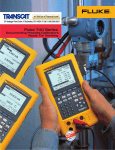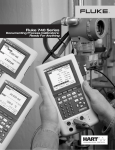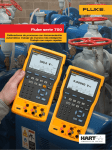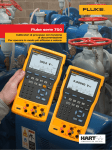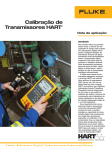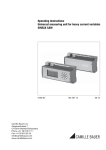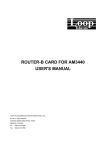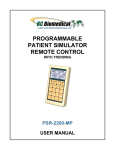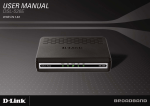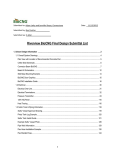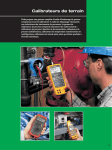Download HART® Transmitter Calibration
Transcript
® HART Transmitter Calibration Application Note Introduction In today’s process plants, most new field instruments are smart digital instruments. Smart implies a microprocessor-based instrument with extra functionality and digital compensation, supporting multiple sensor types or multiple variables. These instruments generally offer better accuracy, long-term stability, and reliability than conventional analog instruments. The most common class of smart instruments incorporates the HART protocol, with more than five million HART instruments in use in 100,000 plants worldwide. HART, an acronym for Highway Addressable Remote Transducer, is an industry standard that defines the communications protocol between smart field devices and a control system that employs traditional 4-20 mA wiring. Two capabilities are required to properly service HART instruments: precision analog source and measure capability and digital communication capability. Until recently, this required two separate tools, a calibrator and a communicator. Today, the capabilities of those two tools are available in a single HART Documenting Process Calibrator that can help you quickly and effectively service HART instruments. HART calibration is required! A common misconception is that the accuracy and stability of HART instruments eliminate the need for calibration. Another misconception is that calibration can be accomplished by re-ranging field instruments using only a HART communicator. Still another misconception is that the control system can remotely calibrate smart instruments. These are not true. All instruments drift. Re-ranging with just a communicator is not calibration. A precision calibrator or standard is required. Regular performance verification with a calibrator traceable to national standards is necessary due to: 1. Shifts in performance of electronic instruments over time, due to exposure of the electronics and the primary sensing element to temperature, humidity, pollutants, vibration, and other field environmental factors. 2. Regulations governing occupational safety, consumer safety, and environmental protection. 3. Quality programs such as ISO 9000 standards for all instruments that impact product quality. 4. Commercial requirements such as weights, measures, and custody transfer. Analog Input Sensor Input Section Sensor Trim Figure 1 2 Fluke Corporation Hart Transmitter Calibration Regular calibration is also prudent since performance checks will often uncover problems not directly caused by the instrumentation, such as solidified or congealed pressure lines, installation of an incorrect thermocouple type, or other errors and faults. A calibration procedure consists of a verification (As Found) test, adjustment to within acceptable tolerance if necessary, and a final verification (As Left) test if an adjustment has been made. Data from the calibration are collected and used to complete a report of calibration, documenting instrument performance over time. All instruments, even HART instruments, must be calibrated on a regular, preventive maintenance schedule. The calibration interval should be set short enough to insure that an instrument never drifts out of tolerance, yet long enough to avoid unnecessary calibrations. Alternatively, the interval may be determined by critical process requirements, e.g., calibration before each batch. PV (digital input) Conversion Section PVAO (digital 4-20 mA) LRV/URV Adjust How are HART instruments properly calibrated? To calibrate a HART instrument consistent with its application, it is very helpful to understand the functional structure of a typical HART transmitter. The article in Appendix A, by Kenneth L. Holladay of Southwest Research Institute, describes a typical HART instrument and defines both proper and improper calibration practices. Originally published in Intech, May 1996, it is reprinted with permission of the author. Note: If you are unfamiliar with HART calibration or need a review, this is an excellent point to stop and read the article in Appendix A. It covers the basics of HART instrumentation and addresses issues critical to instrument maintenance. HART instruments consist of three distinct sections (see Figure 1). Proper HART calibration may involve either or both sensor trim and output trim. Adjusting range values (LRV and URV) without a calibrator is not calibration. Performing an output trim while ignoring the input section is not proper calibration. Adjusting range values with a calibrator may be a practical calibration alternative for instruments operated in 4-20 mA analog mode, provided that the PV and PVAO are not used for process control. Output 4-20 mA Section Output Trim Analog mA Output Analog Measure Value Model Number Analog Source Value PV (Primary Variable) Tag ID PVAO (Digital representation of the Primary Variable Analog Output) PV LRV (Primary Variable Lower Range Value) PV URV (Primary Variable Upper Range Value) Figure 2 New tool speeds calibration Today, instrument maintenance is moving out of the shop and into the field. This reduces process interruptions and avoids the time and expense of returning instruments to the shop. Portable communicators and calibrators are often used to- 3 Fluke Corporation gether to complete field calibrations. However, the desire to carry less equipment and to perform maintenance in the field has created a need for a new class of calibration tool. The new 744 Documenting Process Calibrator from Fluke is the first powerful yet easy-touse tool for field calibration of HART instrumentation. Pressing Hart Transmitter Calibration a single key enters the HART mode and displays the essential HART information in the Active Device Screen, shown in Figure 2. Additional HART functionality is accessed with only a few more keystrokes, per the menu tree in Figure 3. • View process variables Process Basic • View variable map • Re-map process variables (Dual sensor temperature devices) Detailed (coriolis) • Keypad input • Adjust URV, LRV to applied values • Tag • PV units • LRV, URV • Damping • Transfer function Sensor 1 • Sensor serial number • Sensor lower and upper limits • Sensor minimum span Temperature devices only: • Change Sensor Type • Change Sensor Connections • Config Sensor • Config Output Sensor Device Identification Setup • Software Version • Final assembly number • LRV, URV • Damping • Transfer function HART Output Loop test Service Pressure zero trim HART Information Output trim Abort Sensor trim Sensor 2 • Change Sensor Type • Change Sensor Connections (Dual sensor temperature devices) • Dual Sensor Config (Dual sensor temperature devices) • Manufacturer • Model • Device HART ID • Software revision • Hardware revision • Number of preambles • Write protect • Alarm state • HART poll address • HART burst mode • HART burst command Figure 3 4 Fluke Corporation No communicator is required! • Interrogate HART devices to • Read and write HART tag and The 744 requires no external box or communicator for everyday HART calibration and maintenance. It supports many popular models of HART transmitters, with more devicespecific command support than any other HART field calibrator. • • Hart Transmitter Calibration • determine type, manufacturer, model, tag-ID, PV, and PVAO Perform automated HART sensor trim and output trim for selected devices Adjust ranging, damping, and other basic process–configuration settings message fields to re-label smart transmitters Clone additional transmitters with basic HART configuration data Versatile HART protocol support HART operating modes supported The 744 supports the commands contained in HART protocol version 5.7. With 2 MB of memory, the 744 supports a substantial set of HART instructions: • Universal commands — provide functions that are implemented in all field devices, for example, read manufacturer and device type, read primary variable (PV), or read current output and percent of span • Common practice commands — provide functions that are common to many but not all field devices, for example read multiple variables, set damping time, or perform loop test • Device-specific commands — provide functions that are unique to a particular field device, for example sensor trim. The 744 Version 2.5 supports these devices: • For Point to Point operation, the most commonly used mode, connects the 744 to a single HART device in a 4-20 mA loop. • In Multi-Drop mode, several HART instruments can be bussed together. The 744 searches for each, identifies addresses in use, and allows you to select the instrument for calibration and related operations. • In Burst Mode, the HART instrument transmits bursts of data without waiting to be interrogated by a master unit. The 744 can take transmitters out of burst mode during test or calibration, then later restore them to burst mode. Is there still a role for the communicator? Commissioning a HART instrument or modifying HART variables not supported by the 744 requires the use of a communicator. The 744 is designed to Manufacturer Pressure Instruments Temperature Instruments ABB/Kent-Taylor 600T 658T1 1 ABB/ Contrans P, Hartmann & Braun AS 800 Series Endress & Hauser CERABAR S, TMT 1221, TMT 1821, CERABAR M, TMT 1621 DELTABAR S Foxboro Eckardt TI/RTT201 Foxboro/Invensys I/A Pressure Fuji FCX FRC FCXAZ Honeywell ST3000 STT25T1, STT25H1 Micro Motion Moore Products Rosemount Siemens SMAR Viatran Wika Yokogawa 1151 2088 3001C 3051, 3051S SITRANS P DS SITRANS P ES LD301 I/A Pressure UNITRANS EJA HART calibration applications The following examples demonstrate how the 744 makes HART calibration an efficient operation. The 744 enables easy hookup using its HART cable, fast access to the most important HART data, automatic branching to appropriate adjustment choices, automatic completion of test templates, and automatic fetching and sending of analog readings during trim. Coriolis Instruments 2000 2000 IS 9701 9712 9739 3441 3044C 644 3144 3244, 3144P TT3011 T32H1 YTA 110, 310 and 320 1 Table 1 5 Fluke Corporation perform the vast majority of day-to-day operations you normally perform with a separate communicator. The HART capability of the 744 is comparable to that of the model 275 HART communicator, with the exception of the DD interpreter. While the DD interpreter enables the 275 communicator to read command set libraries from any HART supplier, it offers capabilities far beyond those generally required for daily HART instrument maintenance. Hart Transmitter Calibration Sensor Trim not supported Example 1 Calibration of a Rosemount 3051 HART Pressure Transmitter Basic connections This example assumes that the transmitter is isolated from the process and is not electrically connected to a loop power supply. Make basic connections to the 3051 per the diagram in Figure 4. Polarity of the HART communication connection is not important. A separate 250 ohm resistor is not necessary because the 744 incorporates a resistor in series with the 24V loop supply through its mA jacks. The 3051 in this example is configured for psi units. Procedure 1. Power on the Fluke 744 Calibrator. Press the red key followed by the Loop Power softkey and the 744 will display the basic HART information for the 3051 (Figure 5). key again and 2. Press the you are prompted to select the 744 configuration (Figure 6). Selecting MEAS mA, SOURCE psi will configure the calibrator to measure the analog mA output and the pressure being applied simultaneously to the transmitter input and the pressure module. (Selecting MEAS PV, SOURCE psi will configure the 744 to evaluate the digital PV output from the transmitter.) Press to select. ENTER Figure 5 Figure 6 HART Connection Hand Pump 744 DOCUMENTING PROCESS CALIBRATOR S I G N A L + – T E S T MEAS SOURCE V RTD mA V Hz V TC RTD 7 8 9 4 5 6 1 2 3 0 . mA SETUP Pressure Module CLEAR ( ZERO) ENTER mA Pressure Input V RTD CAT 30V MAX SOURCE MEAS 30V MAX 30V MAX 300V MAX TC Red mA Measure, 24V Loop Figure 4 6 Fluke Corporation Hart Transmitter Calibration Black 5. If the As Found test failed 7. Select Output Trim and 3. Vent the pressure line and . The value of the (i.e., there were highlighted press press to zero the pressure primary variable (PVAO) is in errors in the error summary module. Press the As Found the upper right corner of the table), adjustment is necessoftkey, and then press display. This is normally a sary. Press the Adjust to select Instrument for a 4 mA signal. The mA value, softkey. Select Sensor Trim linear transmitter calibration. as constantly measured by and press . (Do not select (If the 3051 is configured for the Fluke 744, is in the cenPressure Zero Trim. It is the square root output, select ter of the display. Press the same as trimming the lower Instrument.) Notice that Fetch softkey to load the sensor point at zero, which is the calibration template is measured mA value. Press useful for pressure transmitautomatically completed with Send to send the value to ters that do not offer Sensor the exception of Tolerance. the 3051 to trim the output Trim.) The 744 screen should Fill in the appropriate test section for the 4 mA value. look like Figure 8. tolerance and press Done. Press Continue for the 20 4. Press the Manual Test mA trim and repeat this step. softkey to begin calibration. 8. After completing Output Trim, Apply the input pressures as press the Done softkey and instructed in the SOURCE proceed with the As Left screen. Press the Accept verification test. Press the As Point softkey when the corLeft softkey. Press Done and rect pressure is applied for then press Manual Test. each point. When the test is Apply the requested prescomplete, the error summary sures and press Accept Point table is displayed (Figure 7). when the readings are Test errors exceeding the stable. On completion an tolerance are highlighted. error summary table is disWhen done viewing the Figure 8 played. If none of the errors table, press the Done softkey. are highlighted (Figure 9), Press Done again to accept, 6. Select Perform user trim – the 3051 passes the calibraor to change the tag, both and press . Zero the tion test. If errors are highserial number or ID fields. pressure module (vented to lighted, the test has failed atmosphere) by pressing . and further adjustment is Press the Continue softkey required. Return to step 5 for and you are prompted for the adjustment of the 3051. Lower Trim value. For best results, apply the LRV pressure and press Fetch to load the value being measured by the pressure module. Press Trim. Then press Continue to move to the Upper Trim. As before, apply the URV pressure, press Fetch, and press Trim. If the 3051 is used with the digital PV Figure 7 output, skip to step 8 and perform the As Left test. If the 4-20 mA analog output is used in the process, conFigure 9 tinue on to step 7. CLEAR ENTER (ZERO) ENTER ENTER ENTER ENTER CLEAR (ZERO) 7 Fluke Corporation Hart Transmitter Calibration Example 2 Calibration of a Rosemount 3144 HART Temperature Transmitter Basic connections This example assumes that the transmitter is isolated from the process and is not electrically connected to a loop power supply. Make basic connections to the 3144 per the diagram in Figure 10. Polarity of the HART communication connection is not important. A separate 250 ohm resistor is not necessary because the 744 incorporates a resistor in series with the 24V loop supply through its mA jacks. The 3144 in this example is configured for a type K thermocouple sensor with a span of 0-300 °C. Procedure 1. Power on the Fluke 744 Calibrator. Press the red key followed by the Loop to Power softkey. Press bypass the warning screens and the 744 will display the basic HART information for the 3144 (Figure 11). ENTER 2. Press the key again and you are prompted to select the 744 configuration (Figure 12). Selecting MEAS mA, SOURCE T/C typ K configures the calibrator to measure the analog mA output of the transmitter and source the correct temperature stimulus at the 3144 input. (Selecting MEAS PV, SOURCE T/C typ K will configure the 744 to evaluate the digital PV output from the transmitter.) Press to select. ENTER Figure 11 HART Connection TC + 744 DOCUMENTING PROCESS CALIBRATOR 2 1 TC – 3 4 – 5 + T 3144 Transmitter MEAS SOURCE mA V Hz V TC RTD 7 8 9 4 5 6 1 2 3 0 . V RTD mA SETUP CLEAR (ZERO) ENTER mA V + RTD Red CAT 30V MAX SOURCE MEAS 30V MAX 30V MAX 300V MAX TC – Black Figure 10 8 Fluke Corporation Hart Transmitter Calibration 5. If the As Found test failed (i.e., there were highlighted errors in the error summary table), adjustment is necessary. Press the Adjust softkey. Select Sensor Trim and press . Select Perform user trim – both and press . The 744 screen should look like Figure 14. ENTER ENTER Figure 12 Figure 15 3. Press the As Found softkey, 8. After completing Output Trim, to select and then press press the Done softkey and Instrument for a linear proceed with the As Left transmitter calibration. Notice verification test. Press the As that the calibration template Left softkey. Press Done and is automatically completed then press Auto Test. On with the exception of the completion, an error summary Tolerance. Fill in the approtable is displayed. If errors priate test tolerance and are highlighted, the test has Figure 14 press the Done softkey. failed and further adjustment is required. Return to step 5 4. Press the Auto Test softkey 6. For best results, press LRV to for adjustment of the 3144. to begin calibration. Once apply the LRV for the Lower the test is complete, an error Trim value. Press Trim and summary table is displayed then Continue to move to (Figure 13). Test errors exthe Upper Trim. Press URV, ceeding the tolerance are press Trim, and then press highlighted. When done Done. If the 3144 is used viewing the table, press the with the digital PV output, Done softkey. Press Done skip to step 8 and perform again to accept, or to the As Left test. If the analog change the tag, serial num4-20 mA output is used in ber or ID fields. the process, continue on to step 7. 7. Select Output Trim and press . The value of the Figure 16 primary variable (PVAO) is in the upper right corner of the display. (Figure 18). This is normally a 4 mA signal. The mA value, as constantly measured by the Fluke 744, is in the center of the display. Press the Fetch softkey to load the measured mA Figure 13 value. Press Send to send the value to the 3144 to trim the output section for the 4 mA value. Press Continue for the 20 mA trim and repeat this step. ENTER ENTER ENTER 9 Fluke Corporation Hart Transmitter Calibration Example 3 Calibration of HART instruments using universal commands The 744 supports a majority of the installed workload of HART transmitters – see Table 1 – by supporting sensor trim, which employs device-specific commands that are unique to a particular instrument. So how can you calibrate instruments that are not supported by the 744? The short answer is that the 744 supports a substantial set of the universal HART commands and the common practice HART commands. The 744 can communicate with virtually any HART instrument and, in most cases, can complete a calibration procedure (except for sensor trim for unsupported instruments). This example applies to instruments used in analog mode (4-20 mA). If the instrument is operated in digital mode, i.e., its PV is the output variable that is used for control, a calibration of the Input Section is all that is needed. Adjustment will require a Sensor Trim, (see Figure 17) which means that for instruments not supported by the 744 you will need to use both a 744 (to perform the As Found and As Left tests and record the results) and a communicator (to perform sensor trim). For instruments used in analog mode, i.e., where the 4-20 mA analog output is used for control, the 744 can be used for calibration. After performing an As Found and determining that Analog Input Sensor Input Section Sensor Trim Figure 17 10 Fluke Corporation Hart Transmitter Calibration adjustment is required, this example first performs an Output Trim to bring the instrument within tolerance. Failing that, the example performs an adjustment to the Lower and Upper Range Values (LRV and URV) to compensate for input section error. Note: Appendix A explains that these adjustments do not constitute a proper HART calibration. While this is true, these adjustments are a practical calibration alternative for instruments operated in 4-20 mA analog mode if error corrections are not large How to determine digital or analog? The transmitter is in digital mode if its HART Poll Address is set between 1 to 15. An address of 0 (zero) sets it to 4-20 mA analog output mode. The 744 will automatically connect to a device at address 0; if a device 744 mA V Hz 8 9 4 5 6 1 2 3 0 . mA SETUP TC RTD 7 V RTD Basic connections This example assumes that the transmitter is isolated from the process and is not electrically connected to a loop power supply. Make basic connections to the transmitter per the diagram in Figure 18. Polarity of the HART communication connection is not important. A separate 250 ohm resistor is not necessary because the 744 incorporates a resistor in series with the 24V loop supply through its mA jacks. This example assumes a type K thermocouple transmitter with an input range of 0-100 °C, 4-20 mA output, and a 0.25% test tolerance. DOCUMENTING PROCESS CALIBRATOR MEAS SOURCE V is not found at 0 the 744 will begin polling addresses 1 to 15. The 744 also displays a nonzero address with the basic HART information. TEST DC PWR CLEAR – ++ – ( ZERO) ENTER mA Red V RTD CAT 30V MAX SOURCE MEAS 30V MAX 30V MAX 300V MAX TC Black Figure 18 PV (digital input) Conversion Section PVAO (digital 4-20 mA) LRV/URV Adjust Output 4-20 mA Section Output Trim Analog mA Output 3. Press the As Found softkey Procedure and press to select 1. Power on the Fluke 744 Instrument calibration. Move Calibrator. Press the key the cursor to Tolerance and and the Loop Power softkey ENTER the appropriate test (if loop power is not already tolerance (0.25% in this exsupplied). Press until any ample). Verify that the 0% device warnings are cleared Value and 100% Value are and the basic HART informathe proper, nominal operattion is displayed (Figure 19). ing values for the transmitter (0.0 °C and 100.0 °C in this example, Figure 21). If the Lower (0%) and Upper Figure 22 (100%) Range Values (LRV If errors are highlighted, and URV) have been previadjustment is necessary by ously modified for calibration performing an Output Trim. purposes, you will need to Press Done to leave the reENTER the nominal values. sults screen, edit the tag, For example, if a previous serial number or ID fields as calibration modified the URV necessary, and press Done to 100.2 °C, you need to again. manually ENTER the nominal value of 100.0 °C for the 5. Press the Adjust softkey, Figure 19 100% Value. Entering nomiselect Output Trim and press nal zero and span values . The value of the primary 2. Press the key again and ensures that errors are calcuvariable (PVAO) is in the you are prompted to select lated correctly. upper right corner of the the 744 configuration (Figure display (Figure 23). This is 20). Move the cursor to normally a 4 mA signal. The MEAS mA, SOURCE T/C real-time mA value as meatyp K, and press . (If you sured by the Fluke 744, is in were verifying the digital PV the center of the display. instead of the mA output, i.e., Press the Fetch softkey to the transmitter has a nonload the measured mA value. zero HART poll address, you Press the Send softkey to would select MEAS PV, send the value to the transSOURCE T/C typ K instead.) mitter to trim the output section for the 4 mA value. Press Continue for the 20 mA adjustment and repeat Figure 21 this step. ENTER ENTER ENTER ENTER Figure 20 4. Press Done and then press Auto Test. Once the test is complete, an error summary table is displayed (Figure 22). Test errors exceeding the tolerance are highlighted. If the test passed, i.e., if no errors are highlighted, adjustment is not required. Figure 23 11 Fluke Corporation Hart Transmitter Calibration 6. Now perform an As Left test. 9. Calculate the new LRV or Press As Left, press Done, URV by multiplying the span and then press Auto Test. On by the error in percent and completion the error sumadding that to the old value. mary table is displayed. If If our example has the folerrors are highlighted, the lowing nominal Source valtest has failed and further ues, errors, and old LRV and adjustment is required. URV values: Note: If the failure error is large, sensor trim adjustment with a communicator may be necessary. Often, however, adjustment can be accomplished with a 744 by modifying the LRV (Lower Range Value) and URV (Upper Range Value) to compensate for Input Section error. 0% Value Source Error% Old LRV/ URV 0.0 ºC 0.84% 0.4 ºC -2.41% 102.0 ºC 100%Value 100.0 ºC Table 2 Figure 24 7. In the case of a pressure 11. Now press Done and then transmitter that has onpress Abort 3 times. PerCalculate the new LRV and board Zero and Span adjustform a new As Found test URV as follows: ment buttons, calibration is by pressing As Found. (ReLRVnew = LRVold + (Span × Error0%) easy. Simply apply a calimember to make sure that brated source at the LRV and the original, nominal zero LRVnew = 0.4 ºC + (100.0 ºC × 0.84%) URV values and press the and span values are shown LRVnew = 0.4 ºC + (100.0 ºC × 0.0084) respective Zero and Span as the 0% Value and 100% buttons on the transmitter. LRVnew = 0.4 ºC + 0.8 ºC Value.) Press Done and Then verify the condition of then press Auto Test. On LRVnew = 1.2 ºC the transmitter by completcompletion, the error suming an As Left test as in step mary table is displayed. URVnew = URVold + (Span × Error100%) 6. Many HART transmitters If errors are highlighted, do not have physical adjustURVnew = 102.0 ºC + (100.0 ºC × the test has failed – repeat ments and need either a –2.41%) the adjustment or trim communicator or a Fluke 744 sensor section with a URVnew = 102.0 ºC + (100.0 ºC × to adjust the LRV and URV communicator. –0.0241) values. For those cases, proNote: If you encounter any difficulty with URVnew = 102.0 ºC – 2.4 ºC ceed to step 8. any of these examples, you may call 1-800URV = 99.6 ºC 44-FLUKE for assistance (1-800-443-5853). 8. The error summary table new (displayed from step 6) provides the data necessary to and then press the make LRV and URV changes. 10. Press Setup softkey. Select Basic Write down the ERROR % from the menu and press values for the failed 0% and to display the basic setup 100% test points. (If the error parameters shown in Figure summary table is no longer 24. To ENTER the new LRV, displayed, you can use the move the cursor to Lower Review Memory softkey to Range Value and press . recall the As Left data.) Type the new LRV and press Return the 744 to the normal . Also type in the new Measure/Source screen disURV and press . Press the playing the As Left softkey Send softkey. by pressing the Done softkey 3 times. ENTER ENTER ENTER ENTER 12 Fluke Corporation Hart Transmitter Calibration a physical quantity into an elec- variable using a communicator, trical signal. However, the simi- this is the value that you see. The second box is strictly a larity ends there. Instead of a mathematical conversion from purely mechanical or electrical Calibrating HART path between the input and the the process variable to the Transmitters resulting 4-20 mA output signal, equivalent milliamp representaBy Kenneth L. Holladay, P.E. a HART transmitter has a micro- tion. The range values of the instrument (related to the zero processor that manipulates the Calibrating a conventional and span values) are used in input data. As shown in Figure instrument conjunction with the transfer A2, there are typically three For a conventional 4-20 mA function to calculate this value. calculation sections involved, instrument, a multiple point test and each of these sections may Although a linear transfer functhat stimulates the input and tion is the most common, presbe individually tested and measures the output is sufficient adjusted. sure transmitters often have a to characterize the overall accuJust prior to the first box, the square root option. Other special racy of the transmitter. The instruments may implement instrument’s microprocessor normal calibration adjustment measures some electrical prop- common mathematical transforinvolves setting only the zero erty that is affected by the pro- mations or user defined break value and the span value, since cess variable of interest. The point tables. The output of the there is effectively only one second block is a digital repremeasured value may be milliadjustable operation between sentation of the desired instruvolts, capacitance, reluctance, the input and output as illusinductance, frequency, or some ment output. When you read the trated below. other property. However, before loop current using a communiit can be used by the micropro- cator, this is the value that you see. Many HART instruments cessor, it must be transformed Zero and Span support a command which puts to a digital count by an analog Adjustments the instrument into a fixed outto digital (A/D) converter. In the first box, the micropro- put test mode. This overrides the Sensing 4-20 mA cessor must rely upon some form normal output of the second Element Output Analog of equation or table to relate the block and substitutes a specified Electronics raw count value of the electrical output value. The third box is the output measurement to the actual propFigure A1 erty (PV) of interest such as tem- section where the calculated Conventional Transmitter Block Diagram perature, pressure, or flow. The output value is converted to a count value that can be loaded principle form of this table is This procedure is often reinto a digital to analog conusually established by the ferred to as a Zero and Span verter. This produces the actual manufacturer, but most HART Calibration. If the relationship instruments include commands analog electrical signal. Once between the input and output again the microprocessor must to perform field adjustments. range of the instrument is not rely on some internal calibration linear, then you must know the This is often referred to as a factors to get the output correct. transfer function before you can sensor trim. The output of the first box is a digital representa- Adjusting these factors is often calculate expected outputs for referred to as a current loop trim tion of the process variable. each input value. Without or 4-20 mA trim. When you read the process knowing the expected output values, you cannot calculate the performance errors. Range and High and Low High and Low Appendix A PV Counts Input Section 13 Fluke Corporation PV Conversion Section PV may be read digitally Figure A2 HART Transmitter Block Diagram Hart Transmitter Calibration mA Output Trim D/A Counts Counts A/D Counts mA For a HART instrument, a multiple point test between input and output does not provide an accurate representation of the transmitter’s operation. Just like a conventional transmitter, the measurement process begins with a technology that converts Transfer Function Sensor Trim PV Calibrating a HART instrument mA Output Section mA may be set and read digitally HART calibration requirements Based on this analysis, you can see why a proper calibration procedure for a HART instrument is significantly different than for a conventional instrument. The specific calibration requirements depend upon the application. If the application uses the digital representation of the process variable for monitoring or control, then the sensor input section must be explicitly tested and adjusted. Note that this reading is completely independent of the milliamp output, and has nothing to do with the zero or span settings. The PV as read via HART communication continues to be accurate even when it is outside the assigned output range. For example, a range 2 Rosemount 3051c has sensor limits of -250 to +250 inches of water. If you set the range to 0 - 100 inches of water, and then apply a pressure of 150 inches of water, the analog output will saturate at just above 20 milliamps. However, a communicator can still read the correct pressure. If the current loop output is not used (that is the transmitter is used as a digital only device), then the input section calibration is all that is required. If the application uses the milliamp output, then the output section must be explicitly tested and calibrated. Note that this calibration is independent of the input section, and again, has nothing to do with the zero and span settings. always a linear relationship between the input and output, and both are recorded in the same engineering units. In general, the desired accuracy for this test will be the manufacturer’s accuracy specification. If the test does not pass, then follow the manufacturer’s recommended procedure for trimming the input section. This may be called a sensor trim and typically involves one or two trim points. Pressure transmitters also often have a zero trim, where the input calculation is adjusted to read exactly zero (not low range). Do not confuse a trim with any form of re-ranging or any procedure that involves using zero and span buttons. Calibrating the output section Again, the same basic multiple point test and adjust technique is employed, but with a new definition for input. To run a test, use a communicator to put the transmitter into a fixed current output mode. The input value for the test is the mA value that you instruct the transmitter to produce. The output value is obtained using a calibrator to measure the resulting current. This test also implies a linear relationship between the input and output, and both are recorded in the same engineering units (milliamps). The desired accuracy for this test should also reflect the manufacturer’s accuracy specification. If the test does not pass, then follow the manufacturer’s recommended procedure for trimCalibrating the input section ming the output section. This may be called a 4-20 mA trim, a The same basic multiple point current loop trim, or a D/A trim. test and adjust technique is employed, but with a new defi- The trim procedure should require two trim points close to or nition for output. To run a test, use a calibrator to measure the just outside of 4 and 20 mA. Do not confuse this with any form applied input, but read the of re-ranging or any procedure associated output (PV) with a communicator. Error calculations that involves using zero and span buttons. are simpler since there is 14 Fluke Corporation Hart Transmitter Calibration Testing overall performance After calibrating both the Input and Output sections, a HART transmitter should operate correctly. The middle block in Figure A2 only involves computations. That is why you can change the range, units, and transfer function without necessarily affecting the calibration. Notice also that even if the instrument has an unusual transfer function, it only operates in the conversion of the input value to a milliamp output value, and therefore is not involved in the testing or calibration of either the input or output sections. If there is a desire to validate the overall performance of a HART transmitter, run a Zero and Span test just like a conventional instrument. As you will see in a moment, however, passing this test does not necessarily indicate that the transmitter is operating correctly. Effect of damping on test performance Many HART instruments support a parameter called damping. If this is not set to zero, it can have an adverse effect on tests and adjustments. Damping induces a delay between a change in the instrument input and the detection of that change in the digital value for the instrument input reading and the corresponding instrument output value. This damping induced delay may exceed the settling time used in the test or calibration. The settling time is the amount of time the test or calibration waits between setting the input and reading the resulting output. It is advisable to adjust the instrument’s damping value to zero prior to performing tests or adjustments. After calibration, be sure to return the damping constant to its required value. Operations that are NOT proper calibrations Digital range change There is a common misconception that changing the range of a HART instrument by using a communicator somehow calibrates the instrument. Remember that a true calibration requires a reference standard, usually in the form of one or more pieces of calibration equipment to provide an input and measure the resulting output. Therefore, since a range change does not reference any external calibration standards, it is really a configuration change, not a calibration. Notice that in the HART transmitter block diagram (Figure 2), changing the range only affects the second block. It has no effect on the digital process variable as read by a communicator. Zero and span adjustment Using only the zero and span adjustments to calibrate a HART transmitter (the standard practice associated with conventional transmitters) often corrupts the internal digital readings. You may not have noticed this if you never use a communicator to read the range or digital process data. As shown in Figure 2, there is more than one output to consider. The digital PV and milliamp values read by a communicator are also outputs, just like the analog current loop. Consider what happens when using the external zero and span buttons to adjust a HART instrument. Suppose that an instrument technician installs and tests a differential pressure transmitter that was set at the factory for a range of 0 to 100 inches of water. Testing the transmitter reveals that it now has a 1 inch of water 15 Fluke Corporation zero shift. Thus with both ports vented (zero), its output is 4.16 mA instead of 4.00 mA, and when applying 100 inches of water, the output is 20.16 mA instead of 20.00 mA. To fix this he vents both ports and presses the zero button on the transmitter. The output goes to 4.00 mA, so it appears that the adjustment was successful. However, if he now checks the transmitter with a communicator, he will find that the range is 1 to 101 inches of water, and the PV is 1 inch of water instead of 0. The zero and span buttons changed the range (the second block). This is the only action that the instrument can take under these conditions since it does not know the actual value of the reference input. Only by using a digital command which conveys the reference value can the instrument make the appropriate internal adjustments. The proper way to correct a zero shift condition is to use a zero trim. This adjusts the instrument input block so that the digital PV agrees with the calibration standard. If you intend to use the digital process values for trending, statistical calculations, or maintenance tracking, then you should disable the external zero and span buttons and avoid using them entirely. Loop current adjustment Another observed practice among instrument technicians is to use a hand-held communicator to adjust the current loop so that an accurate input to the instrument agrees with some display device on the loop. If you are using a Rosemount model 268 communicator, this is a “current loop trim using other scale.” Refer again to the zero drift example just before pressing the zero Hart Transmitter Calibration button. Suppose there is also a digital indicator in the loop that displays 0.0 at 4 mA, and 100.0 at 20 mA. During testing, it read 1.0 with both ports vented, and it read 101.0 with 100 inches of water applied. Using the communicator, the technician performs a current loop trim so that the display reads correctly at 0 and 100, essentially correcting the output to be 4 and 20 mA respectively. While this also appears to be successful, there is a fundamental problem with this procedure. To begin with, the communicator will show that the PV still reads 1 and 101 inches of water at the test points, and the digital reading of the mA output still reads 4.16 and 20.16 mA, even though the actual output is 4 and 20 mA. The calibration problem in the input section has been hidden by introducing a compensating error in the output section, so that neither of the digital readings agrees with the calibration standards. As published in Intech, May 1996 and also in HART Book 8, July 1998. Reprinted with the permission of the author. Documentation of results The scheduling of calibrations, creation of procedures and documentation of your calibration results are facilitated by a number of instrumentation management software packages: DocuMint ™ PRM (Plant Resource Manager) from Yokogawa Electric Corporation. ™ OnTimeSupport ™ Fluke DPC/TRACK ™ Meridium ProCALV Intools Ordering Information FLUKE-744 Documenting Process Calibrator-HART Includes: TL224 Industrial Test Leads (two sets), AC220 Test Clips (2 sets), TP220 Test Probes (1 set), BP7235 NiMH Battery Pack, BC7217 Battery Charger, serial port cable, HART communications cable, DPC/TRACK Sample with free PC communication utility software, Instruction Manual, HART User’s Manual, NISTtraceable calibration certificate and data, three-year warranty. Optional Accessories Fluke. Keeping your world up and running. IT ANAG E M E NT YM S T YS ® R TI 90 01 ISO 9001 FI ED TO M E E T Hart Transmitter Calibration IS O For more information call: U.S.A. (800) 443-5853 or Fax (425) 446-5116 Europe/M-East/Africa +1 (31 40) 2 675 200 or Fax +1 (31 40) 2 675 222 Canada 1-800-36-FLUKE or Fax (905) 890-6866 Other countries +1 (425) 446-5500 or Fax +1 (425) 446-5116 Web access: http://www.fluke.com ©2004 Fluke Corporation. All rights reserved. Printed in U.S.A. 12/2004 1262439 A-US-N Rev F 16 Fluke Corporation EM Fluke Europe B.V. PO Box 1186, 5602 BD Eindhoven, The Netherlands AL Fluke Corporation PO Box 9090, Everett, WA USA 98206 CE Fluke-700BCW Fluke-700PTP Fluke-700TC1 Fluke-700TC2 BE9005 BC7217 BP7217 BP7235 C700 C781 C789 Pressure Modules Included with each Fluke Pressure Module: BSP-ISO to NPT Adapter(s) (except with P29 - P31), Instruction Sheet, NIST traceable calibration report and data, one-year warranty. Bar Code Wand Pneumatic Test Pump, 360 psi/25 bar TC Mini-Plug Kit, 9 types TC Mini-Plug Kit, JKTERS Battery Eliminator Battery Charger NiCd Battery Pack NiMH Battery Pack Hard Carrying Case Soft Carrying Case Soft Carrying Case QU Fluke-700 Pxx
















